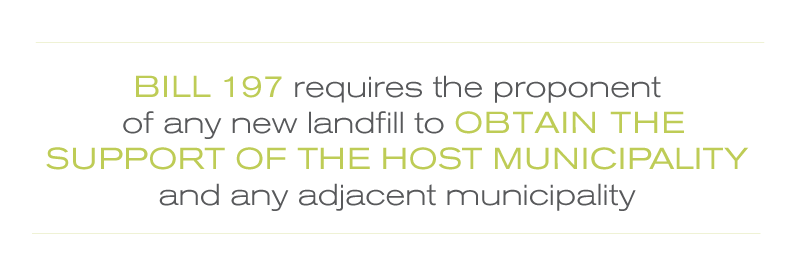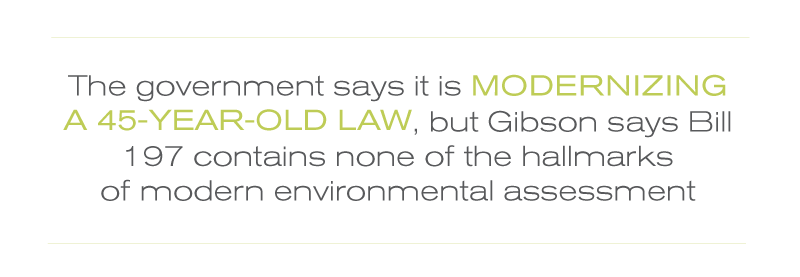Environmental and industry implications of Ontario’s Bill 197
 by Mark Sabourin
by Mark Sabourin
Freelance Writer. Campbellford, Ontario
[email protected]
August 10, 2020
Click here to download the PDF version ![]()
Ontario’s Bill 197 may spur development, but critics wonder at what cost?
The history of planning in Ontario has been marked by an ebb and flow of power between municipalities and the province, says municipal and environmental lawyer Catherine Lyons, a partner at Goodmans LLP in Toronto. While the Ford government has seemed inclined to flow power back to municipalities, Bill197, the COVID-19 Economic Recovery Act, 2020, does a bit of both.
On the one hand, Bill 197 makes amendments to the Planning Act, enhancing the power of the Minister of Municipal Affairs and Housing to issue Minister’s Zoning Orders (MZO) to land outside the greenbelt. It enacts a new statute, the Transit-Oriented Communities Act, 2020, which gives the minister more power to work with private developers on priority transit projects. On the other hand, Bill 197 requires the proponent of any new landfill to obtain the support of the host municipality and any adjacent municipality within 3.5 km of the landfill’sgates.
Recent Rise in Minister’s Zoning Orders
Previously, MZOs had been used sparingly — mostly in areas of the province without municipal organization or where there are no zoning bylaws. Lyons says the Ford government appears to have turned to them more often, sometimes to smooth the path for its priority projects – a new long-term care home, for instance, or an expansion to Toronto’s Sunnybrook hospital. But the new MZO authority and the Transit-Oriented Communities Act are both about transit, Lyons says.
“I think it’s saying that transit is a priority and [the government is] prepared to limit public input and municipal input into it,” says Lyons. Expediting transit is a good thing, she adds. A lack of transit infrastructure only puts more people in cars, “and that’s so bad for the environment.”
But then so are the changes to the Environmental Assessment Act brought in by Bill 197, says Robert Gibson, Professor in the School of Environment, Resources and Sustainability at the University of  Waterloo.
Waterloo.
Bill 197 Changes Lack ‘Modern’ Impact Considerations — Critics
The government says it is modernizing a 45-year-old law, but Gibson says Bill 197 contains none of the hallmarks of modern environmental assessment, such as decisionmaking centred on sustainability, application to all undertakings, whether public or private, transparency, a commitment to Indigenous consultation and explicit attention to climate change mitigation.
What Bill 197 does do is:
• Allow for the creation of a project list in place of the current requirement that all provincial government activities, plans or proposals be subject to EA unless exempted;
• Replace the existing 10 Class Environmental Assessment processes with a quicker, more streamlined process;
• Require that shovels hit the ground within a fixed period (the government is suggesting 10 years) of an environmental assessment approval;
• Severely limit ”bump-up” requests – applications to have an individual EA performed on a Class EA project;
• Require new landfills to obtain the approval of the host municipality, and the approval of any other adjacent municipality that is within 3.5 km of the proposed landfill’s gate.
The requirement for municipal support of new landfills is one of the sections that is in force now. Mike Chopowick, CEO of the Ontario Waste Management Association, says it is difficult to see why a proponent would even bring forward a proposal for a new landfill in the province. It’s too high-risk a proposition.
Need for Reform
Caroline Coburn, Managing Director of Odonaterra, an environmental consulting firm in North Bay, ON with a particular focus on Indigenous communities, says Bill 197, the COVID-19 Economic Recovery Act, has nothing to do with COVID-19 or economic recovery.
“It feels like the Conservatives are trying to pull a fast one,” she says. The Environmental Assessment Act is in need of reform, she continues, but this Bill isn’t it. There’s very little in Bill 197 that aligns the Environmental Assessment Act with the federal Impact Assessment Act, little about recognizing Indigenous rights under section 35 of the Constitution Act, and nothing about the UN Declaration on the Rights of Indigenous Peoples. The province should repeal Bill 197 and write a new Environmental Assessment Act in consultation with Indigenous people and other Ontarians, and do so at a time where they’re not distracted by a pandemic, she urges. It’s too important to be rushed through.
“They call it red tape. They call it delay,” says Dianne Saxe, the former Environmental Commissioner of Ontario and now president of Saxe Facts.
Bill Rushed Through Parliament
 Bill 197 was rushed. The government limited debate, bypassed committee hearings and posting on the Environmental Registry, and pushed the Bill through the legislature in little more than a day.
Bill 197 was rushed. The government limited debate, bypassed committee hearings and posting on the Environmental Registry, and pushed the Bill through the legislature in little more than a day.
Most of the environmental assessment changes must await enabling regulations, which the government has said it will post on the environmental registry for public comment. But Saxe cautions that public comment is only as effective as the government’s willingness to listen. “If Cabinet doesn’t care, if the government of the day doesn’t care, then it’s a done deal.” And she figures the government doesn’t care. “I haven’t seen any evidence that this government values public consultation,” says Saxe.
 Should Ontarians Be Concerned?
Should Ontarians Be Concerned?
If Saxe is right, Ontarians should be concerned. “I think [Bill 197] is going to be a topic of contention going forward,” says environmental lawyer Janet Bobechko, Senior Partner at Norton Rose Fulbright Canada LLP. The government’s intentions, and the true impact of Bill 197, will be revealed only when draft regulations are published for comment. Regulations will spell out what is, and is not, on the project list. They’ll lay out the streamlined assessments that will replace the 10 Class EAs. They’ll prescribe standard terms of reference.
Streamlined Assessments
None of this is necessarily bad. Bump-ups were widely abused as a delaying tactic, for instance. But Class EAs, which were introduced to speed up approval of projects with known effects, are not a big problem, says Bobechko, and replacing them with streamlined assessments may give rise to a new set of problems if they’re not informed with the right technical expertise.
Standard terms of reference might be a good idea, provided they can be written.
“Is an intersection or a sewer main replacement in downtown Toronto the same as one in a sensitive setting or a different urban setting?” she asks.
More Clarity and Guidance Needed
Needed
How will the amended Act facilitate harmonization with the federal Impact Assessment Act? And of course the granddaddy of them all: what will make it onto the project list, and what will be left off?
“If I was a municipality, I would go through the legislation very carefully,” she says.
Lawyers, developers,consultants, municipalities, will also need plenty of guidance material to navigate the transition to the new system that emerges. Bill 197 says something about projects that are caught in the EA process when the transition occurs, but it’s far from clear, says Bobechko.
There’s plenty at stake, Saxe warns. “The whole point of doing an assessment is learning something you don’t know,” she says. The cost of a poor environmental assessment can take time to reveal itself. “When you pave a wetland or drain agricultural land, that’s almost permanent. By the time your home floods, it’s too late.”

